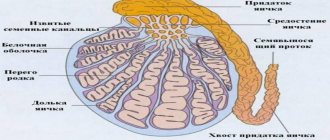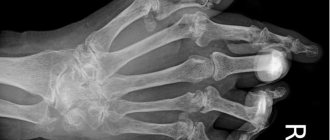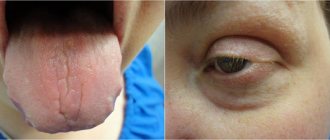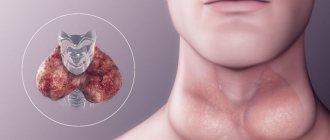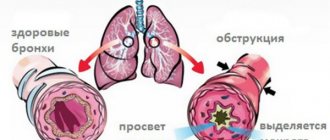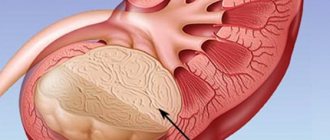Diabetes insipidus is a disease that develops when there is a lack of production of antidiuretic hormone or a decrease in the susceptibility of the kidney tissue to its effects. As a result, there is a significant increase in fluid that is excreted in the urine and an unquenchable thirst appears. If complete fluid compensation does not occur, this leads to the development of dehydration (dehydration) of the body. A distinctive feature of dehydration is inspiratory syndrome - frequent urination.
Diabetes insipidus is considered a rare involutional endocrinopathy. Symptoms appear with equal intensity in men, women and children. The disease can occur as one of the complications of neurosurgical intervention. A decrease in the processes of reabsorption (reabsorption) of a certain amount of fluid in the renal tubules and its excretion in low-density urine occurs due to disturbances in the production of antidiuretic hormone by the hypothalamus.
What is diabetes insipidus?
Diabetes insipidus is a disease characterized by the absence of the effects of vasopressin in the body.
Dysfunction of the hormone may be associated with a violation of its synthesis or with pathology of receptors for vasopressin in the periphery (primarily in the kidneys).
The only mechanism that supports the reuptake of water from primary urine in humans is the action of antidiuretic hormone. If this factor stops working, then a severe violation of water-mineral metabolism develops.
Diabetes insipidus is characterized by:
- large volume of diuresis (urine significantly more than 2 liters per day);
- low concentration of salts in urine;
- dehydration;
- electrolyte disturbances;
- hypotension, etc.
Classification
The main factors that provoke diabetes insipidus
This disease is associated with disturbances in the functioning of the brain, and the following factors can provoke it:
- head injuries (both open and closed);
- malignant brain tumors;
- cancer metastases in the brain;
- sarcoidosis;
- meningitis;
- encephalitis;
- severe infectious diseases leading to brain damage;
- autoimmune disorders;
- syphilis;
- vascular pathologies of the brain;
- cerebral aneurysms;
- craniopharyngeoma;
- brain surgery.
Types of disease
There are two forms of this disease depending on the level at which disturbances are observed:
Hypothalamic or central diabetes is a consequence of impaired synthesis or release of antidiuretic hormone into the blood. It, in turn, has two subspecies:
- idiopathic diabetes – associated with a hereditary pathology in which antidiuretic hormone is produced in small quantities;
- symptomatic diabetes - may be the result of other diseases, such as brain tumors, infectious inflammatory processes of the meninges, or trauma.
Modern endocrinology classifies diabetes insipidus depending on the level at which disorders occur. There are central (neurogenic, hypothalamic-pituitary) and renal (nephrogenic) forms of diabetes insipidus.
In the central form, disorders develop at the level of secretion of antidiuretic hormone by the hypothalamus or at the level of its release into the blood.
In the renal form, there is a disturbance in the perception of ADH by the cells of the distal tubules of the nephrons. .
There are these types of diabetes insipidus:
- Central diabetes insipidus (neurogenic) is characterized by a lack of vasopressin, which causes a disturbance in the concentration of urine at the level of the distal tubules of the nephron, which begins to be released in excessive volumes. At the same time, the thirst center is activated, provoking polydipsia.
- Renal (nephrogenic) diabetes insipidus occurs due to the insensitivity of the renal epithelial receptors to vasopressin, which may be the result of a mutation in the receptor gene.
- Diabetes insipidus in pregnancy (transient) usually stops progressing after childbirth and does not need to be treated. But if signs of dehydration suddenly appear, treatment should be carried out as for the central type.
Forecast
The idiopathic form of this disease does not pose a serious threat to human life.
But it is important to note that cases of complete recovery are quite rare.
Gestational and iatrogenic diabetes can be cured easily and quickly. Proper use of treatment helps maintain ability to work.
If you experience increased urination and unquenchable thirst, you should immediately contact your doctor.
Causes of diabetes insipidus
Diabetes insipidus is a disease caused by vasopressin deficiency, its relative or absolute deficiency. Antidiuretic hormone (vasopressin) is produced in the hypothalamus and, among other functions in the body, is responsible for normalizing urination.
Based on etiological characteristics, there are three types of diabetes insipidus. idiopathic, acquired and genetic.
For most patients with this rare disease, the cause is still unknown. This type of diabetes is called idiopathic and affects up to 70 percent of patients.
Genetic is a hereditary factor. In this case, diabetes insipidus sometimes affects several family members and several generations in a row.
More often, the central form of diabetes insipidus is detected, associated with hypothalamic-pituitary destruction as a result of primary or metastatic tumors, neurosurgical interventions, vascular, tuberculosis, malaria, syphilitic lesions, etc.
In idiopathic diabetes insipidus, there is no organic damage to the hypothalamic-pituitary system, and the cause is the spontaneous appearance of antibodies to hormone-producing cells.
The renal form of diabetes insipidus can be caused by congenital or acquired kidney diseases (renal failure, amyloidosis, hypercalcemia) or lithium poisoning.
Congenital forms of diabetes insipidus most often develop with autosomal recessive inheritance of Wolfram syndrome, which in its manifestations can be complete (with the presence of diabetes insipidus and diabetes mellitus, optic nerve atrophy, deafness) or partial (combining diabetes mellitus and diabetes insipidus).
Diabetes insipidus in children, features
Diabetes insipidus develops especially severely and quickly in children under one year of age. In addition to the main symptoms described above, the baby very quickly becomes dehydrated, prefers water to breast milk, but since he cannot say about his constant thirst, he dies very quickly.
Signs of severe dehydration include dry crying, sunken fontanelles, lack of voice, convulsions and loss of consciousness.
As a rule, the causes of such an early form are perinatal or congenital pathology, or developmental abnormalities of the central nervous system.
Diagnostic signs of diabetes
Symptoms of diabetes insipidus allow a preliminary diagnosis to be made. The final diagnosis is made only after examining the sick woman. The following studies are organized:
- clinical urine analysis;
- analysis according to Zimnitsky;
- determination of the concentration of antidiuretic hormone in the blood;
- physical examination;
- blood pressure measurement;
- Magnetic resonance imaging;
- electrocardiography;
- Ultrasound of the kidneys and bladder;
- general blood analysis.
To exclude diabetes mellitus, blood glucose levels are assessed.
The following signs indicate that a woman has diabetes insipidus:
- urine density below 1005;
- low concentration of vasopressin in the bloodstream;
- decreased potassium levels in the blood;
- increased levels of sodium and calcium in the blood;
- increase in daily diuresis.
If a renal form of diabetes is detected, a consultation with a urologist is required. If the genital organs are involved in the process and the menstrual cycle is disrupted, a consultation with a gynecologist is necessary.
Additionally, special tests may be performed. An MRI of the brain is done to evaluate the condition of the hypothalamus and pituitary gland.
How to eliminate symptoms
The most characteristic symptoms of diabetes insipidus are polyuria (urine is excreted in quantities significantly higher than the daily norm) and polydipsia (drinking large amounts of water).
During the day, urine output in patients can range from four to thirty liters, which is determined by the severity of the disease.
Urine is practically uncolored, characterized by low density, and virtually no salts or other compounds are found in it.
Due to the constant desire to drink water, patients with diabetes insipidus consume very large amounts of liquid. The volume of water drunk can reach up to eighteen liters per day.
Symptoms are accompanied by sleep disturbances, increased fatigue, neuroses, and emotional imbalance.
The following signs of diabetes insipidus in women are distinguished:
- constant thirst;
- weight loss;
- frequent and copious urination;
- dry mouth;
- decreased appetite;
- pain in the epigastric region;
- sleep disturbance;
- myalgia;
- weakness;
- decreased performance;
- menstrual irregularities;
- emotional lability;
- decreased blood pressure;
- dry skin.
Dysuric phenomena come to the fore. Normally, the daily diuresis of a healthy person is 1-1.5 liters.
This is secondary urine, which is concentrated. If the process of urine formation is disrupted, the urine becomes more dilute.
Polyuria and pollakiuria are the earliest symptoms of diabetes insipidus in women. The volume of urine excreted varies from 3 to 20 and even 30 liters per day.
Sick women urinate around the clock...
The symptoms of the disease can be eliminated with the help of medications. Therapeutic tactics depend on the form of diabetes insipidus.
For diabetes of central origin, treatment involves a course of replacement therapy with antidiuretic hormone analogues.
For this purpose, “Minirin” or “Adiuretin” is used. Medicines are available in the form of tablets or nasal drops.
To stimulate the production of antidiuretic hormone, drugs such as Carbamazepine, Chlorpropamide, and Miscleron are prescribed.
Elimination of the underlying pathology is of no small importance. In case of tumors, surgical treatment or radiation therapy is required.
In cases of severe dehydration, infusion therapy is performed. Its goal is to normalize the salt composition of the blood and increase its volume.
Sick women do not need to limit fluid intake. Hypothiazide is often used to reduce diuresis in diabetes insipidus.
Nutrition plays an important role in treatment. Patients must follow a diet.
It involves limiting the consumption of protein foods and enriching the diet with carbohydrates and lipids. The consumption of table salt is also limited to 5-6 g per day.
Despite the lack of appetite, food should be taken often and in small portions. To replenish the blood with electrolytes, it is recommended to drink compotes, fruit drinks, and natural juices.
Despite the various causes that lead to the development of diabetes insipidus, the signs of the disease are almost the same for all variants of its course.
However, the severity of the manifestations of the disease depends on two points:
- How resistant are nephron tubule receptors to vasopressin?
- degree of antidiuretic hormone deficiency or absence
As a rule, the onset of the disease is sudden, but it can develop gradually.
The very first signs of the disease are severe, painful thirst (polydipsia) and frequent excessive urination (polyuria), which bother patients even at night.
From 3 to 15 liters of urine can be released per day, and sometimes its amount reaches up to 20 liters per day. Therefore, the patient is tormented by severe thirst.
Later, as the disease progresses, the following symptoms appear:
The disease occurs with normal symptoms. However, in women, the menstrual cycle is sometimes disrupted, infertility develops, and pregnancy ends in spontaneous miscarriage.
The symptoms described above will be accompanied by a decrease in libido (attraction to the opposite sex) and potency (male impotence).
In adolescents and children over three years of age, the symptoms of the disease are practically no different from those in adults.
However, sometimes the signs of the disease are not clearly expressed. the child eats poorly and gains weight, suffers from frequent vomiting when eating, has constipation and bedwetting, and complains of joint pain.
In this case, the diagnosis is made late, when the child is already lagging behind in physical and mental development.
Whereas in newborns and infants (especially with the renal type), the manifestations of the disease are striking and differ from those in adults.
Symptoms of diabetes insipidus in children under one year of age:
Typical manifestations of diabetes insipidus are polyuria and polydipsia. Polyuria is manifested by an increase in the volume of daily urine excreted (usually up to 4-10 l, sometimes up to 20-30 l).
Urine is colorless, with a small amount of salts and other elements and a low specific gravity (1000-1003) in all portions. The feeling of unquenchable thirst in diabetes insipidus leads to polydipsia - the consumption of large amounts of fluid, sometimes equal to that lost in urine.
The severity of diabetes insipidus is determined by the degree of antidiuretic hormone deficiency.
Idiopathic diabetes insipidus usually develops acutely, suddenly, and less often - gradually increasing. Pregnancy can trigger the manifestation of the disease.
Frequent urge to urinate (pollakiuria) leads to sleep disturbances, neuroses, increased fatigue, and emotional imbalance.
In children, the early manifestation of diabetes insipidus is enuresis, later delayed growth and puberty occur. .
Although this disease can be triggered by various reasons, its symptoms are almost always identical for all “scenarios” of its development, both in men and in children.
At the same time, the degree to which manifestations are expressed depends on the following points..
- how little susceptible cells and parts of nephron tubules are to vasopressin;
- variability of antidiuretic hormone deficiency or its absolute absence.
Men who have experienced this disease note that diabetes insipidus always begins quite unexpectedly. The initial symptoms of the disease are polydipsia (extreme debilitating thirst) and frequently repeated heavy urination at any time of the day, including at night.
From three to 15 liters of urine can be produced daily. In some cases, this amount can reach 18-21 liters.
It is in connection with this that patients, including children, are tormented by debilitating thirst.
As the disease progresses, other symptoms appear, namely:
If we talk about what symptoms occur in children, they include:
Considering that the causes of the disease may be different, the symptoms of diabetes insipidus generally do not differ for its different types.
But the degree to which the disease manifests itself depends on two factors:
- level of immunity of nephron tubule receptors to antidiuretic hormone;
- level of ADH deficiency.
The disease falls into the category of those that start suddenly and acutely. The kidneys stop collecting and concentrating urine, which the patient feels in the form of excessive urination and severe thirst.
The peculiarity of the disease is that the resulting thirst is almost unquenchable. The volume of fluid consumed can reach up to 7 liters per day.
In this case, the amount of urine released can range from 7 liters to 25 liters in one day. Such urination can be even more painful in women during menstruation.
Often because of this, women experience sudden incontinence; the process is especially difficult at night. .
If in men and women symptoms manifest themselves in the form of thirst and a high amount of urine discharge, then in children the symptoms are most pronounced.
Small children immediately fall into a serious condition. They develop an extremely high temperature, and there are signs of severe intoxication of the body.
Such children often show all the signs at once, which makes the condition worse. .
In older children, symptoms become less intense. Typically, adolescent children do not have a variety of symptoms.
The only pronounced symptom is enuresis at night. However, in some cases, children may become lethargic and complain of headaches.
As a rule, they get tired quickly and are capricious for no reason. .
Neurological disorders against the background of dehydration can develop in a spiral and reach collapse. In children, tachycardia may increase up to angina pectoris.
Some children, on the contrary, experience severe weakness and bradycardia. There is a delay in physical or mental development.
Signs of diabetes insipidus are expressed to varying degrees in patients. The main complaints are related to extreme thirst, dry skin, dry mouth and increased urine output.
Symptoms of the disease:
- fluid requirement more than 6 liters per day;
- increase in urine volume to 6-20 liters per day;
- increased nocturnal diuresis;
- sleep disorders;
- severe weakness and fatigue;
- decreased saliva secretion;
- digestive disorders;
- interruptions in heart function;
- decreased blood pressure;
- rapid pulse;
- weight loss;
- dry and itchy skin;
- nausea and vomiting;
- skeletal muscle cramps;
- neurological symptoms;
- increased body temperature;
- urinary incontinence (in children after 4 years).
Diagnosis of diabetes insipidus
Typical cases allow one to suspect diabetes insipidus by unquenchable thirst and the release of more than 3 liters of urine per day. To assess the daily amount of urine, a Zimnitsky test is performed.
When examining urine, its low relative density (<1005), hyponatriuria (urine hypoosmolarity - 100-200 mOsm/kg) is determined.
Plasma hyperosmolarity (hypernatremia) (> 290 mOsm/kg), hypercalcemia and hypokalemia are detected in the blood. Diabetes mellitus is excluded by determining fasting blood glucose.
In the central form of diabetes insipidus, a low level of ADH is determined in the blood. .
The results of the test with dry eating are indicative. abstaining from drinking liquids for 10-12 hours.
With diabetes insipidus, weight loss of more than 5% occurs, while maintaining low specific gravity and hypoosmolarity of urine. The causes of diabetes insipidus are clarified by X-ray, psychoneurological, and ophthalmological examinations.
Space-occupying lesions of the brain are excluded by performing an MRI of the brain. To diagnose the renal form of diabetes insipidus, ultrasound and CT scans of the kidneys are performed.
Consultation with a nephrologist is necessary. Sometimes a kidney biopsy is required to differentiate renal pathology.
Diabetes insipidus in children can be detected by performing certain tests:
- Zimnitsky's test;
- determination of the degree of osmolarity and relative density of urea (it determines the filtering ability of the kidneys), as well as the specificity of blood serum;
- computed tomography or nuclear magnetic resonance of the brain (cannot be performed among children);
- X-ray of the sella turcica, as well as the skull.
Thus, the presented illness has very specific symptoms that are difficult to confuse with any others.
They need prompt treatment, because untimely prevention can be a serious threat to life.
Typically, the diagnosis of this disease is quite simple and is based on:
- pathologically increased thirst;
- the volume of urine excreted is more than three liters per day;
- hyperosmolarity of blood plasma (more than 290 mOsm/kg);
- high sodium content;
- urine hypoosmolarity (100–200 mOsmol/kg);
- low specific gravity of urine (<1010).
An X-ray, psychoneurological, and ophthalmological examination will also be required. It will be necessary to conduct an MRI (magnetic resonance imaging) of the brain.
Signs and symptoms of diabetes insipidus
1) The main symptom is polyuria - a frequent urge to release large volumes of urine.
2) The second striking symptom is polydipsia - excessive thirst, which in this case is the result of water loss through urine. It encourages a person with this disease to drink large volumes of fluid. 3) Having to urinate can disrupt sleep. The volume of urine passed each day can range from 3 to 20 liters, and up to 30 liters in the case of central ND.
4) Symptoms that are secondary include dehydration due to loss of water. This is especially true in children who cannot communicate their thirst. Children may become lethargic, have a fever, vomiting and/or diarrhea, and may have stunted growth. Another vulnerable group is people with dementia, who are also often unable to drink water on their own.
5) Extreme dehydration can lead to hypernatremia, a condition in which low water intake causes the sodium concentration in the blood to become very high and the body's cells are deprived of water. Hypernatremia can lead to neurological symptoms such as neuromuscular irritability, confusion, seizures, or even coma.
By the way, we recommend reading the article 12 main signs of diabetes in men
Treatment of diabetes insipidus
After confirming the diagnosis and determining the type of diabetes insipidus, therapy is prescribed aimed at eliminating the cause that caused it - tumors are removed, the underlying disease is treated, and the consequences of brain injuries are eliminated.
To compensate for the required amount of antidiuretic hormone for all types of disease, desmopressin (a synthetic analogue of the hormone) is prescribed. It is applied by instillation into the nasal cavity.
For central diabetes insipidus, chlorpropamide, carbamazepine and other medications are used that activate the formation of vasopressin.
An important part of therapeutic measures is the normalization of water-salt balance, which consists of administering large quantities of salt solutions in the form of infusions. To reduce urine excretion from the body, hypothiazide is prescribed.
If you have diabetes insipidus, you must follow a diet that includes foods with minimal protein and a large amount of carbohydrates and fats.
This will reduce the load on the kidneys. Patients are advised to eat frequently and in small portions.
The diet should contain plenty of fruits and vegetables. For drinking, it is better to use not water, but various compotes, juices or fruit drinks.
Idiopathic diabetes insipidus does not pose a threat to the patient's life, but complete recovery is extremely rare. Iatrogenic and gestational types of diabetes, on the contrary, are most often completely cured and are transient in nature.
Gestational diabetes insipidus in pregnant women disappears completely after childbirth (with proper treatment), and iatrogenic diabetes insipidus disappears after discontinuation of the drugs that caused it.
Doctors must prescribe competent replacement therapy so that patients can maintain their ability to work and lead a normal lifestyle.
The most unfavorable form of diabetes insipidus in terms of prognosis is nephrogenic diabetes insipidus in childhood.
Treatment of symptomatic diabetes insipidus begins with eliminating the cause (for example, a tumor). For all forms of diabetes insipidus, replacement therapy with a synthetic analogue of ADH, desmopressin, is prescribed.
The drug is administered orally or intranasally (by instillation into the nose). A prolonged preparation of pituitrin oil solution is also prescribed.
In the central form of diabetes insipidus, chlorpropamide and carbamazepine are prescribed, which stimulate the secretion of antidiuretic hormone.
The water-salt balance is corrected by infusion of saline solutions in large volumes. Sulfonamide diuretics (hypochlorothiazide) significantly reduce diuresis in diabetes insipidus.
Nutrition for diabetes insipidus is based on limiting protein (to reduce the load on the kidneys) and sufficient consumption of carbohydrates and fats, frequent meals, and an increase in the amount of vegetable and fruit dishes.
As for drinks, it is recommended to quench your thirst with juices, fruit drinks, and compotes. .
After determining the specific cause that caused diabetes insipidus, the doctor may prescribe drug therapy.
Treatment of central diabetes insipidus
Treatment will take into account the volume of fluid that the patient loses daily in urine:
- When urine volumes are less than four liters per day, medications are not prescribed. It is only necessary to restore the balance of incoming and outgoing fluid, and diet is also required.
- When urine volumes exceed four liters per day, replacement therapy is used, during which substances that act as ADH or substances that improve the performance of this hormone will be prescribed.
Treatment with medications
The drug Minirin is used as a substitute for vasopressin. The dosage of the drug does not depend on the age or weight of the patient; only the degree of ADH deficiency or its absolute absence plays a role.
In general, the dosage is prescribed individually. The minimum doses are prescribed at first, and then during the first few days they can be increased if necessary.
Usually the drug needs to be taken about three times a day.
To stimulate the performance of the hormone, a medicinal substance called Chlorpropamide (which has an effective effect when combining two types of diabetes - diabetes mellitus and diabetes insipidus), Carbamazepine, Miscleron is prescribed.
The most important thing for this type of diabetes insipidus is to restore the amount of fluid that enters the body, after which certain medications can be prescribed.
Most often, drug treatment is prescribed to reduce the volume of urine produced. For this purpose, thiazide diuretics are used, such as:
- Hydrochlorothiazide;
- Triampur;
- Indapamide.
Anti-inflammatory drugs may also be used to block certain substances from entering the nephron's urinary tubules, which reduces the amount of urine produced and increases osmolarity.
Suitable medications include Ibuprofen, Aspirin and Indomethacin.
Treatment always begins with diagnostics in order to identify the root cause that triggered diabetes insipidus. If these are tumors or carcinomas, immediate surgery is prescribed.
Drug therapy is based on the artificial addition of synthetic vasopressin to the body. Vasopressin is available in any form: nasal drops, tablets, sprays.
But the most effective treatment is with a drug such as Minirin. It compensates for the lack of the hormone, which has a positive effect on the functioning of the kidneys: the amount of urine is significantly reduced. The patient ceases to feel constant thirst due to the fact that irritation of the brain stops.
It is better to take Minirin in tablets, primarily because it is impossible to mix them up or accidentally take more. Then, as when putting it in the nose or using a spray, this is much easier to do.
The patient is also prescribed large volumes of water-salt droppers. This is necessary to quickly restore the desired level of water and electrolyte balance.
It is important to pay attention to nutrition. The diet should contain a lot of phosphorus, since with a protracted course of the disease, an acute shortage occurs in the body.
Consultation with a neuropsychiatrist is very important if there are signs of disturbances in the functioning of the central nervous system. The neurologist should prescribe mild sedatives and sedatives to relieve insomnia or restore the deep phase of sleep.
The degree of effectiveness of therapy is assessed by the patient’s well-being and the amount of fluid loss.
There are 3 stages:
- compensation;
- subcompensation;
- decompensation.
Patients with compensated disease do not have symptoms of diabetes insipidus. In the subcompensation stage, moderate polyuria and polydipsia are observed.
In patients with decompensation, treatment is absolutely ineffective (the daily volume of urine remains within the same pathological limits)..
Treatment for diabetes insipidus depends on the type of pathology:
- the central form is treated with tablets, drops or spray with the synthetic hormone desmopressin;
- Renal diabetes insipidus is treated with thiazide diuretics and some nonsteroidal anti-inflammatory drugs.
Desmopressin is a synthetic analogue of vasopressin. It has been used to treat the central form of the disease since 1974.
Desmopressin provides a pronounced and long-lasting antidiuretic effect. The synthetic hormone has virtually no effect on vascular tone and systemic blood pressure.
The initial dose of desmopressin is 0.1 mg half an hour before meals 3 times a day or 10 mcg intranasally 2 times a day. Average daily doses are 0.1-1.6 mg orally or 10-40 mcg in the form of drops or spray.
The need for medication is not related to the gender of the patient. Typically, a lower dose is needed for patients with postoperative or post-traumatic diabetes insipidus.
And the greatest needs are in patients with the idiopathic form. High doses are needed in every tenth patient with central diabetes insipidus.
It is advisable for them to be prescribed intranasal drugs.
Patients must be instructed in proper drinking regimen. If the feeling of thirst is impaired, then drinking a fixed amount of water every day should be recommended.
Overdose of drugs leads to complications:
- decrease in sodium concentration in the blood;
- increased pressure;
- development of edema;
- disturbance of consciousness.
All these symptoms are associated with water intoxication.
Renal diabetes insipidus is usually more difficult to treat. Most often, the volume of urine does not decrease to normal, but only by 40-50% of the initial values.
Treatment is carried out with thiazide diuretics and non-steroidal drugs. These drugs directly affect the kidneys.
Treatment does not eliminate the cause of the disease—the pathology of vasopressin receptors. In addition, long-term use of medications can have adverse effects on the patient's health.
In cases of partial diabetes insipidus or mild forms of the disease, non-drug therapy may be used for treatment.
Its basis is sufficient drinking regime. Dehydration is prevented by consuming adequate amounts of water and salts.
Endocrinologist Tsvetkova I.G.
Recommended viewing:
Diagnostics
First of all, the patient needs to undergo an appropriate test for polyuria.
In the absence of health problems, the amount of urine produced will not be more than three liters per day.
Consequently, patients with this disease significantly exceed this indicator. In addition, the doctor may pay attention to the fact that people with this disease have minimal urine density.
During the relevant examination, the patient should refrain from drinking large amounts of liquid. This must be done for eight hours.
With a sudden decrease in urine density over a given time period to values of no more than 300 mOsm/l, the diagnosis called “diabetes insipidus” is confirmed.
It is important to note that differential diagnosis involves excluding the insulin-dependent form of diabetes.
It is also envisaged to exclude the presence of various neoplasms of a benign or malignant nature in the hypothalamic-pituitary region.

